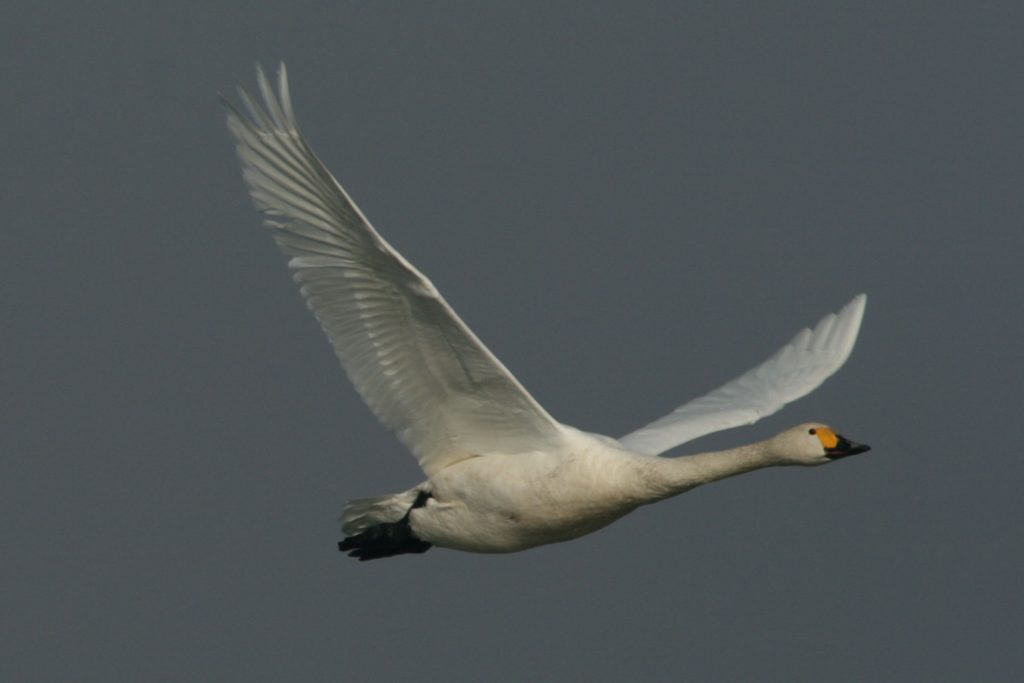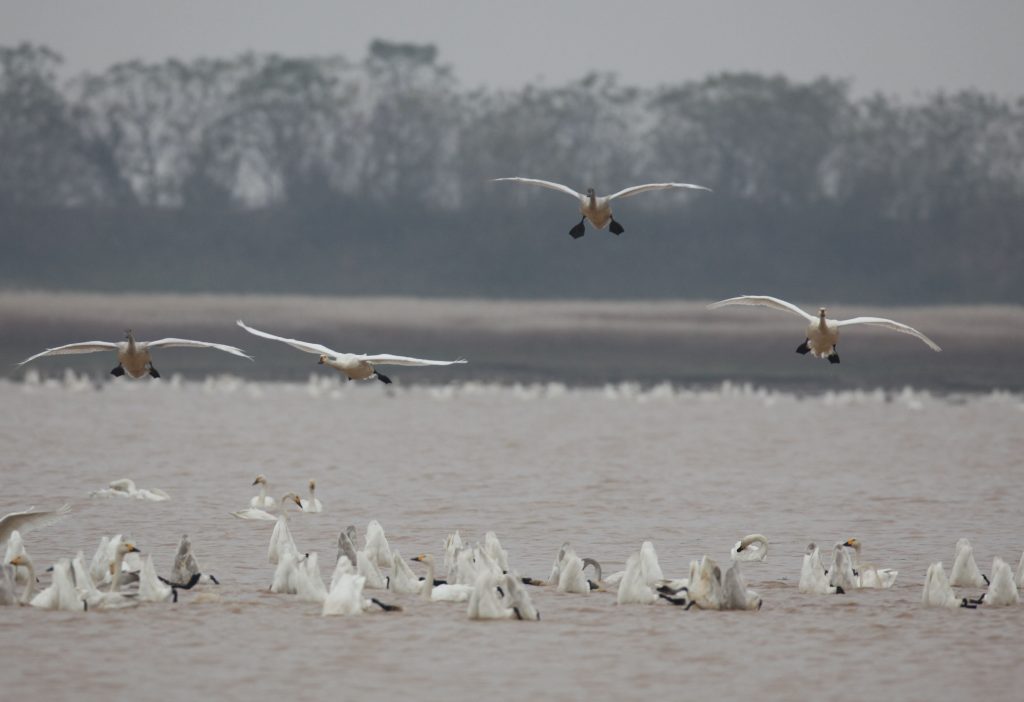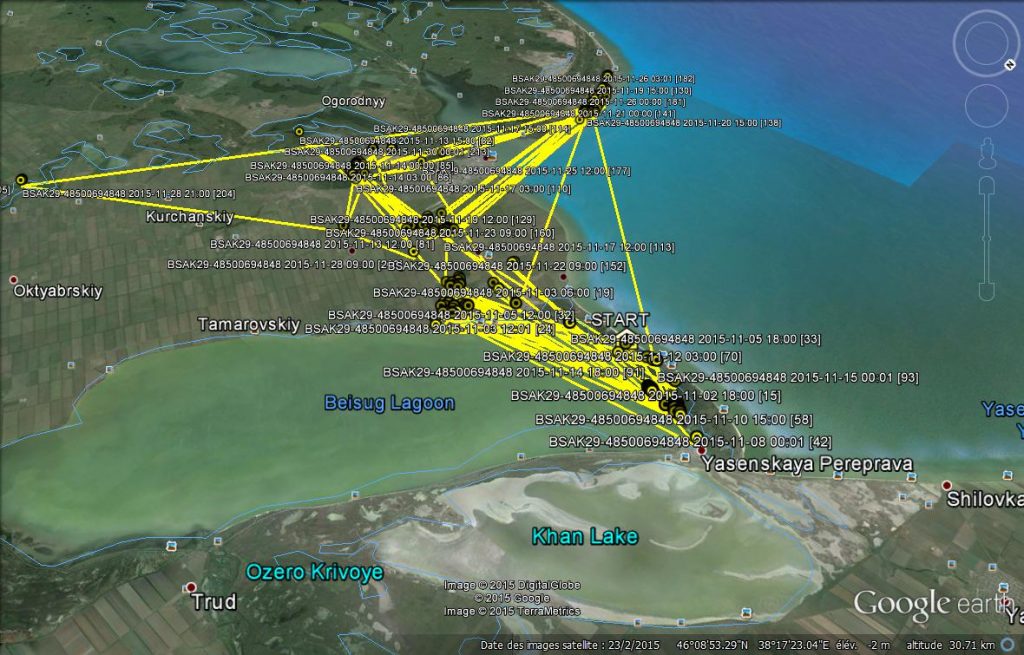The objective of this program is to understand how and why, within a few years, thousands of Bewick’s Swans have decided to spend the winter in the Evros Delta. Beyond that we hope to participate to understand why the population wintering in the southern North Sea region decline inexorably for 15 years. The first results are … totally unexpected!
The locations transmitted every three hours by the GPS/GSM transmitters carried on by the Bewick’s Swans we ringed in the Yamal Peninsula in August 2015 can be seen by logging on to the geographical application that is to access throughout the link right above this post.
The first two Bewick’s left the Yamal tundra on 11/09/2015. These are the swans 843X and 854X, both are immature males. The following three headed south on 14, 19 and 22 September. No transmission was received so far from the transmitter of the sixth swan, 801X. Is it the consequence of a technical problem? Was the transmitter lost in an area outside GSM network? Was the swan predated by a White-tailed Eagle? Each hypothesis is possible.

The five swans migrate separately, despite having been ringed in the same region within a few days. They all go south, flying over the taiga. But when in sight of Omsk and Novosibirsk regions, the swans 820X, 832X and 865X skew towards the east.
Between 30/09/2015 and 05/10/2015, these three swans stopped separately on Ubinskoye lake located 200 km from the city of Novosibirsk and 1650 km from the mouth of the Yuribey where they have been tagged. After a few hours or a few days stopover, each of the three leaved to the east-southeast, crossed Khakassia, flying over the Altai Mountains. 865X was the first to cross the border between Russia and Mongolia. But he quickly landed on Lake Uvs nur where he halted for two days. He then moved again towards the north, passing the Russian border again reaching a lake at 1200 m altitude near the town of Kak. He stayed there for 12 days. The 28/10/2015, in the early morning, he took the air again and traveled 3150 km in three days to reach the suburbs of Shanghai, China! INCREDIBLE ! After some hesitation, he landed on 01/11/2015 on Poyang Lake, one of the largest wintering site for waterfowl in China with a 3500km² surface and over 500,000 waterbirds counted during the winter. Of these, tens of thousands of Bewick’s Swans. Until now it was thought that these birds were originating from Eastern Siberia, and certainly not from Yamal peninsula situated just at the border with Europe. The Bewick Swan 865X traveled almost 6500 km in five weeks. On 26/11/2015, he was joined by 820X and 832X swans. Incredible triple!

Two other swans also regularly transmit their position. After leaving from Yamal they headed also south overflying the taiga to reach the steppes of northern Kazakhstan. 843X travelled the route in one week. He stops on 18/09/2015 on a small lake and then another where he refueled until 17/10/2015. He flies at short distance only stopping next day on another lake located 270 km to the west. West ! So in the opposite direction of the three Bewicks en route to China! His logger is silent since. The swan 854X followed the same way. Between 5 and 21/10/2015, he stopped on a lake Akpas situated 100 km from Bewick 843X. He left the site to fly towards the southwest to reach the Caspian Sea. After a stop of less than 6 hours in the Volga delta, close to Astrakhan, he reoriented to the northwest, overflying – but not stopping – over the marshes of Kumo Manych where every Red-breasted Goose we had equipped with a transmitter in Siberian tundra during previous summers had a stopover. On 23/10/2015 at 11:00, 854X landed on the liman of Beisug on the east coast of the Sea of Azov.

In less than 48 hours, 854X traveled 2300 km. What will he do next? Continue his journey to the west and join the Evros Delta and the Mediterranean? Or wintering in the Azov Sea? Both sites are only at 1100 km distance.
We are in a triple new situation!
843X will hopefully allow us to discover this new migration route that connects the tundra of Siberia to the Evros Delta via northern Kazakhstan and Azov Sea.
820X, 832X and 865X are in China, in the Yangtze River Basin. Probably no one imagined such a connection with the tundra of Yamal, so close to Europe.
Bewick’s Swans ringed from the same flock, at the same place, at the same time, are going to spend the winter in wetlands situated at 7100 km distance.
The geographical application to view the journey of the Bewick’s Swans equipped with a GPS/GSM transmitter in the peninsula Yamal was realized by Philippe Vandevondele and Yves Tassin from Intergraph Belgium (Hexagon Safety & Infrastructure).

